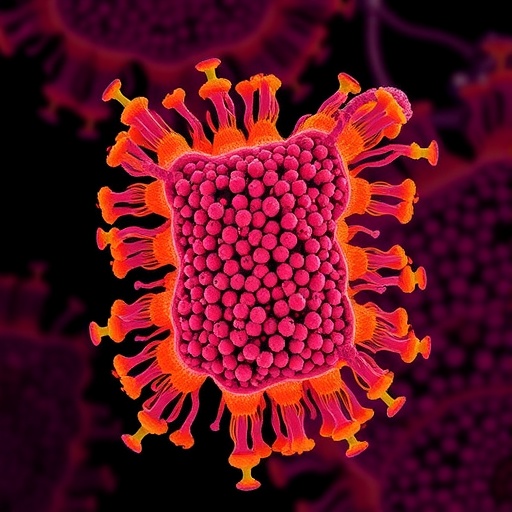
In recent research published in Annals of Biomedical Engineering, a pioneering study has revealed critical insights into the mechanical forces acting on the pulmonary artery that can significantly affect the remodeling of the right ventricle in patients who have undergone repair for Tetralogy of Fallot (ToF). This condition, which is one of the most common congenital heart defects, comprises a combination of four heart defects that result in insufficient oxygenation of blood. For many patients, surgical intervention during infancy is essential, but post-operative complications can arise that significantly impact long-term health, particularly concerning right ventricular function.
The study, conducted by a team led by researchers including E.W. Thompson and A. Bhattacharya, utilizes advanced imaging and computational fluid dynamics to understand how shear stress and the oscillatory shear index affect right ventricular remodeling. These terms refer to the forces exerted by blood flow on the walls of blood vessels, with shear stress being the tangential force and oscillatory shear index indicating the variation of that force over time. It has become increasingly evident that these biomechanical factors play crucial roles not only in the immediate outcome of surgical candidates but also in their long-term cardiac health.
One of the primary revelations from the study is the correlation between increased pulmonary artery shear stress and negative remodeling of the right ventricle. This remodeling refers to the structural changes that the right ventricle undergoes in response to altered hemodynamic conditions, which can include hypertrophy (thickening of the heart muscle) and dilation. Such changes can lead to right heart failure if not identified and addressed adequately. The findings suggest that measuring shear stress in these patients can serve as an important biomarker for potential right ventricular dysfunction.
Moreover, the oscillatory shear index surfaces as another critical variable indicating adverse effects on the right ventricle. Fluctuations in flow dynamics, characterized by oscillatory shear, can signify disturbed flow patterns that are commonly seen in patients post-ToF repair. These disturbed flows are believed to incite inflammatory pathways that can contribute to pathological remodeling and greater risks for arrhythmias. Thus, understanding and quantifying the oscillatory shear index offers valuable insight into the management of patients who have undergone heart repair surgeries.
The implications of this research are profound. As healthcare continues to evolve, incorporating biomechanical evaluations into routine post-operative assessments could markedly enhance the prediction and prevention of long-term complications in individuals with repaired ToF. Cardiologists and surgical teams could leverage this knowledge to tailor follow-up care, potentially employing interventions that mitigate the identified mechanical stresses on the heart.
Furthermore, the collaboration between engineers and medical professionals in this study underscores the importance of interdisciplinary approaches to tackling complex medical challenges. Innovations in imaging technology and computational modeling pave the way for future studies that may encompass larger patient cohorts and longitudinal evaluations, providing a more comprehensive understanding of mechanical influences on cardiac remodeling over time.
A meaningful aspect of this research is the potential for the development of proactive strategies to manage right ventricular health. Through skilled integration of advanced biotechnologies, medical professionals can explore targeted therapies that address the specific mechanical alterations observed in the pulmonary artery. This could involve pharmaceutical options that aim to modify flow behaviors or interventions that concern lifestyle changes to improve cardiovascular fitness.
By elucidating the associations between shear stress and oscillatory shear metrics with right ventricular outcomes, the authors of this study contribute to a burgeoning repository of knowledge that may guide clinical decision-making and improve risk stratification for patients with congenital heart defects. The insights from this research stand to transform current clinical practices and inspire further inquiry into the long-term management of patients with repaired Tetralogy of Fallot.
Importantly, the research indicates that further investigations should also be focused on preventive approaches that not only monitor but also proactively manage identified risks associated with mechanical heart stressors. Future studies may explore various therapeutic modalities that could facilitate improved patient outcomes and quality of life for individuals who have undergone surgical repairs of congenital heart defects.
In conclusion, the linking of pulmonary artery shear stress and oscillatory shear index with right ventricular remodeling in this notable study reflects a significant advancement in our understanding of the biomechanical aspects of congenital heart disease. This research encourages the integration of mechanical metrics into routine clinical practice, facilitating enhanced patient monitoring and personalized treatment approaches that take into account individual hemodynamic landscapes.
Through the diligent efforts of researchers and clinicians alike, patients with repaired Tetralogy of Fallot may experience improved health outcomes, with reduced incidences of post-operative complications. The unfolding narrative of the interplay between fluid dynamics and cardiac health remains a critical frontier with profound implications for the future of congenital heart disease management.
Subject of Research: Mechanics of pulmonary artery shear stress and its implications for right ventricular remodeling in congenital heart disease.
Article Title: Pulmonary Artery Shear Stress and Oscillatory Shear Index are Associated with Right Ventricular Remodeling in Repaired Tetralogy of Fallot.
Article References: Thompson, E.W., Bhattacharya, A., Hu, F. et al. Pulmonary Artery Shear Stress and Oscillatory Shear Index are Associated with Right Ventricular Remodeling in Repaired Tetralogy of Fallot. Ann Biomed Eng 53, 2206–2222 (2025). https://doi.org/10.1007/s10439-025-03793-0
Image Credits: AI Generated
DOI: https://doi.org/10.1007/s10439-025-03793-0
Keywords: Shear Stress, Oscillatory Shear Index, Right Ventricular Remodeling, Tetralogy of Fallot, Congenital Heart Defects, Biomechanics, Long-term Health Outcomes, Computational Fluid Dynamics, Interdisciplinary Research, Cardiac Remodeling, Preventive Cardiology, Heart Surgery Outcomes
Tags: advanced imaging techniques in cardiologybiomechanical factors in heart diseasecardiac function after ToF surgerycomputational fluid dynamics in heart researchcongenital heart defect repairE.W. Thompson A. Bhattacharya researchlong-term health outcomes congenital heart defectsmechanical forces in cardiovascular healthoscillatory shear index impactpost-operative complications heart surgeryright ventricular remodeling Tetralogy of Fallotshear stress in pulmonary artery




